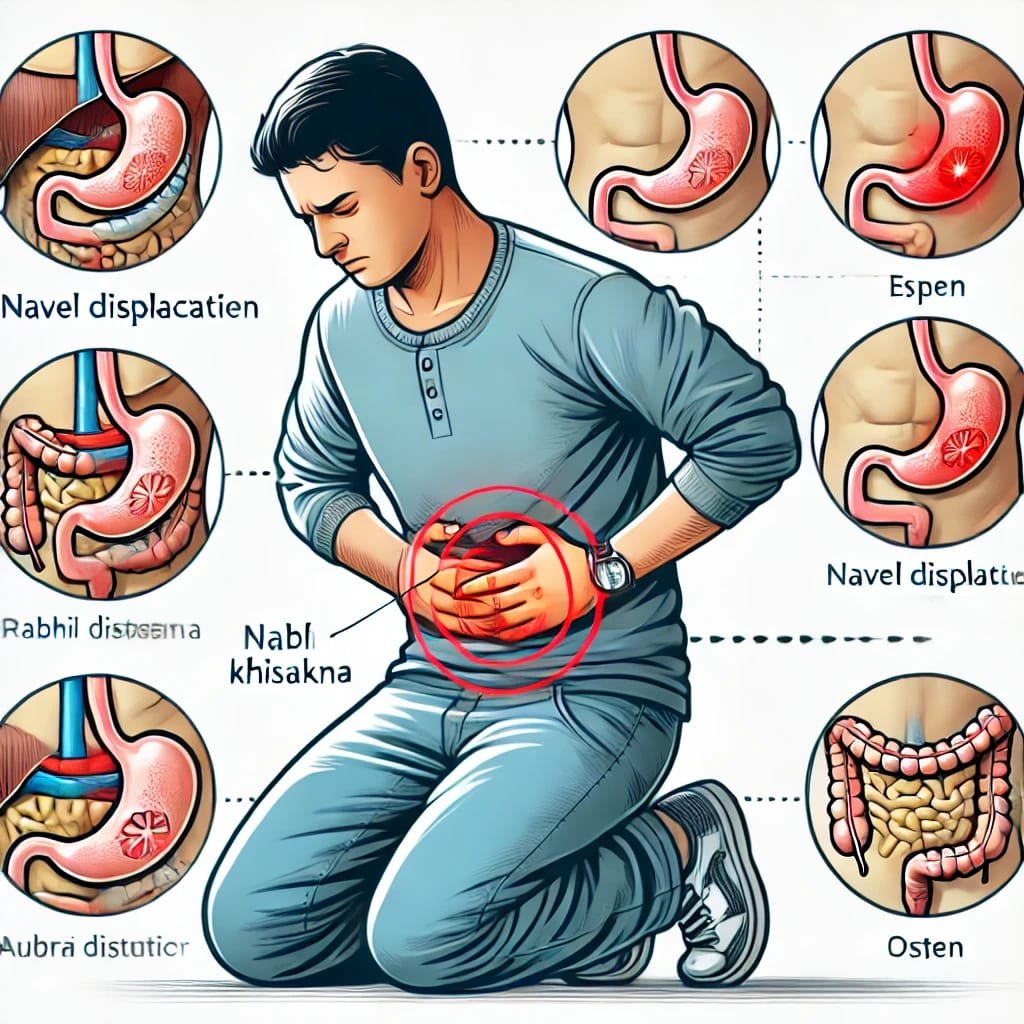Introduction
How to treat navel displacement naturally:-Navel displacement, commonly referred to as “Nabhi khisakna” in Hindi, is a condition that isn’t widely recognized in conventional medical literature but is a common concept in traditional practices, particularly in India. The condition is believed to occur when the navel (umbilicus) shifts from its central position, leading to various health issues. Although not scientifically proven, many people believe in this condition and seek remedies for it. This article delves into the types, causes, symptoms, risks, and remedies associated with navel displacement.

What is Navel Displacement?
Navel displacement is believed to occur when the navel moves from its natural central position. This displacement can happen vertically, horizontally, or diagonally. The condition is thought to affect the balance of the body and disrupt the normal flow of energy, leading to various physical and emotional issues.
Types of Navel Displacement
1. Vertical Displacement: This type occurs when the navel shifts upward or downward. It is believed to cause digestive issues, constipation, or diarrhea.
2. Horizontal Displacement: In this type, the navel moves sideways, leading to issues such as back pain, muscle strain, or discomfort in the legs.
3. Diagonal Displacement: A combination of both vertical and horizontal displacement, this type is considered the most severe and may cause a range of symptoms including digestive problems, anxiety, and general weakness.
Causes of Navel Displacement
While modern medicine does not recognize navel displacement as a medical condition, those who believe in it attribute it to several causes:
1. Physical Strain: Lifting heavy objects, sudden jerky movements, or engaging in intense physical activities can lead to navel displacement.
2. Digestive Issues: Chronic constipation or diarrhea is believed to disturb the balance of the abdomen, potentially leading to a shift in the navel’s position.
3. Injury or Trauma: A fall, accident, or a direct blow to the abdominal region can cause the navel to shift from its natural position.
4. Emotional Stress: High levels of stress and anxiety are also considered contributing factors, as they may lead to muscle tension in the abdominal area.
Symptoms of Navel Displacement
The symptoms of navel displacement vary depending on the type and severity of the condition:
1. Digestive Problems: Bloating, constipation, diarrhea, and stomach cramps are common symptoms associated with navel displacement.
2. Muscle Pain: Those experiencing navel displacement often report pain in the lower back, legs, or abdominal muscles.
3. Fatigue and Weakness: A general feeling of weakness and lack of energy is another symptom attributed to this condition.
4. Emotional Disturbances: Anxiety, irritability, and mood swings are sometimes linked to navel displacement, although this is more anecdotal than evidence-based.
Risks Associated with Navel Displacement
While navel displacement is not recognized as a life-threatening condition, it is believed to cause discomfort and reduce the quality of life for those who experience it. The risks mainly revolve around the chronic nature of the symptoms, which can lead to a cycle of discomfort and distress.
1. Chronic Pain: Persistent muscle and abdominal pain can become debilitating if left untreated.
2. Digestive Disorders: Ongoing digestive issues can lead to more severe problems such as malnutrition or severe dehydration.
3. Mental Health Issues: Chronic pain and discomfort can lead to anxiety, depression, and other mental health challenges.
Remedies for Navel Displacement
Although navel displacement lacks scientific backing, many traditional practices offer remedies believed to realign the navel and alleviate symptoms:
1. Abdominal Massage: One of the most popular remedies is a deep abdominal massage performed by a trained practitioner. This massage is believed to help reposition the navel and restore balance in the body.
2. Yoga and Stretching Exercises: Certain yoga poses and stretching exercises are thought to help realign the navel and strengthen the core muscles. Poses like Bhujangasana (Cobra Pose) and Pavanamuktasana (Wind-Relieving Pose) are particularly recommended.
3. Dietary Adjustments: Eating a balanced diet that promotes healthy digestion is considered crucial. Foods rich in fiber, probiotics, and hydration are often suggested to improve digestive health and prevent further displacement.
4. Herbal Remedies: Traditional medicine also suggests the use of herbs such as asafoetida, cumin, and ginger to improve digestion and alleviate symptoms associated with navel displacement.
5. Rest and Relaxation: Reducing physical strain and emotional stress is important in managing and preventing navel displacement. Practices like meditation, deep breathing, and adequate rest are encouraged.
6. Bandaging Techniques: In some traditional practices, a tight bandage is wrapped around the abdomen to support the navel and prevent further displacement. This technique is usually performed under the guidance of an experienced practitioner.
READ MORE-How to prevent typhoid

Conclusion
How to treat navel displacement naturally:-While navel displacement remains a concept rooted in traditional beliefs rather than scientific evidence, many people find relief through various remedies. Whether through massage, yoga, or dietary adjustments, those who believe in this condition have developed a range of practices to address it. If you suspect you have navel displacement, it’s important to consult with a healthcare provider to rule out other potential causes of your symptoms and to explore treatment options that work best for you.
